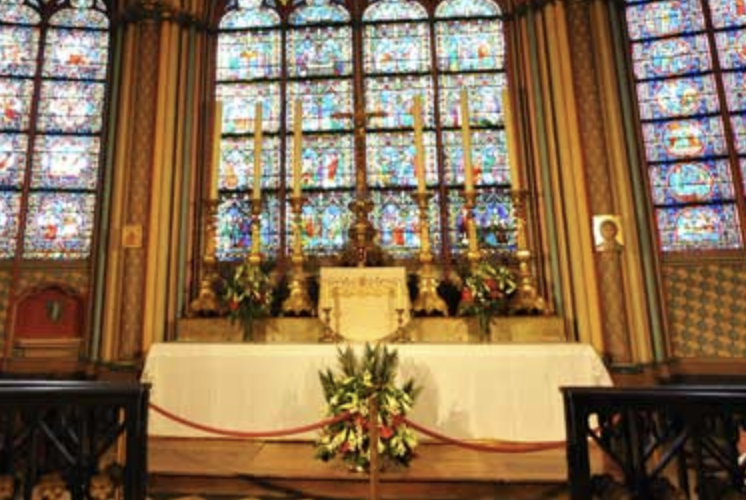I’m almost 100% that what The Times’ reporter is referring to here is not a *statue* of Jesus, but the Blessed Sacrament.
File under: religious illiteracy https://t.co/5n3kQD7pk8 pic.twitter.com/rD3C9vIS8J
— Sohrab Ahmari (@SohrabAhmari) April 18, 2019
OK, Catholic readers of GetReligion (and you know who you are), we have a solution to a journalism mystery that many noticed in the wave of coverage following the fire at Notre Dame Cathedral.
The big question raised by The New York Times: What’s the difference between a “statue” of Jesus and a priest carrying the Blessed Sacrament”? Hold that thought.
Let’s start with Father Jean-Marc Fournier, chaplain of the Paris Fire Brigade and one of the heroes of efforts to save what could be saved inside the iconic cathedral. Quite a few people are reporting stories about the actions that he took when it became clear that there was no way to stop the flames in the wooden structures holding up the cathedral roof.
Here’s the top of my “On Religion” column for this week, which led with this angle of the story:
As the flames rushed through Notre Dame Cathedral’s wooden rafters — each beam cut from an individual oak — a squad of firefighters began a strategic mission.
Their leader was Father Jean-Marc Fournier, chaplain of the Paris Fire Brigade. The goal was to save a crown of thorns that pilgrims have venerated for centuries as part of one worn by the crucified Jesus. King Louis IX brought the relic to Paris in 1238, after receiving it as a gift from the embattled emperor of Constantinople.
Fournier and his firefighters were, according to KTO Catholic Television, able to “save the crown of thorns and the Blessed Sacrament.” Forming a human chain, they retrieved as many relics and works of sacred art as they could, until the flames won.
Meanwhile, American television networks solemnly told viewers that “art,” “artifacts” and “works of art” had been retrieved from this iconic structure at the heart of Paris. In a major story about the fire, The New York Times noted that Notre Dame Cathedral had “for centuries … enshrined an evolving notion of Frenchness.”
So here is a basic religion-beat journalism challenge: How does one describe the “Blessed Sacrament” in a few phrases? Some journalists struggled with that.
For some reporters, the crucial issue was trying to turn “sacraments” and holy relics into “art” and “artifacts.” Thus, in my column I wondered if a “container of what Catholics believe is bread consecrated to be the Body of Christ” should be “described as a ‘cultural artifact’.”
But it was this overture in a major Times story — “The Chaplain, the Cathedral Fire and the Race to Rescue Notre-Dame’s Relics” — that sent some Catholics through the roof:
PARIS — By the time the Paris Fire Department’s chaplain made his way inside Notre-Dame, flames had already consumed most of the cathedral’s roof and its spire had smashed onto the nave.
But the flames had yet to reach many of the artworks, artifacts and relics, and it was the Rev. Jean-Marc Fournier’s job to guide his colleagues through the many chapels and alleys of the burning cathedral and tell them which to save first.
“I had two priorities: to save the crown of thorns and a statue of Jesus,” Father Fournier said.
Yes, this was a direct quote.
So what did the priest actually say that turned into “a statue of Jesus”? Maybe he said, in theological language, the “Body of Christ”? Someone then turned that into “statue”?
Another beautiful passage in this story only added to the mystery:
As the chaplain began removing a statue of Jesus, he said, his colleagues were fighting the fire from the cathedral’s towers. The flames had started to threaten the wooden structure around the belfry — putting the whole cathedral at even greater risk.
With the statue in hand, Father Fournier, alone in the nave, gave a benediction to the cathedral, he said.
“I thought Jesus could help us a little bit and work, too,” he said. “I invited him to worry about his own house if he didn’t want to finish the night under a tent by the Canal Saint-Martin.”
The priest blessed the burning cathedral with … A STATUE?
Wait, there’s more. The final lines of the story said:
Most of the artworks, artifacts and relics have been moved to the Louvre museum, Prime Minister Édouard Philippe said on Wednesday.
As for Father Fournier, he said he hoped to hold that statue of Jesus again soon. “Preferably in a safe place,” he said. “One that has a roof.”
I could not make sense out of this. In all of the coverage of Father Fournier’s actions, I had never a reference to a statue. After all, a stone or metal statue might survive a fire, to some degree.
But here’s the big idea, in terms of theology. In this situation, any Roman Catholic priest would do everything he could to save the Blessed Sacrament, which is kept in a tabernacle near the altar, if not on it.
Now the mystery is solved. That Times report ends with this correction:
Correction: April 18, 2019
An earlier version of this article misidentified one of two objects recovered from Notre-Dame by the Rev. Jean-Marc Fournier. It was the Blessed Sacrament, not a statue of Jesus.
OK, I will ask the editors the obvious question: What is the Blessed Sacrament, in Times language? What is the theological claim behind that term?
Just asking.
LMAO the New York Times translated “the body of Christ” into “a statue of Jesus” pic.twitter.com/wy6PSm3W0V
— Jeremy McLellan (@JeremyMcLellan) April 18, 2019
FIRST IMAGE: Chapel of the Holy Sacrament, Notre Dame Cathedral — before the fire.











